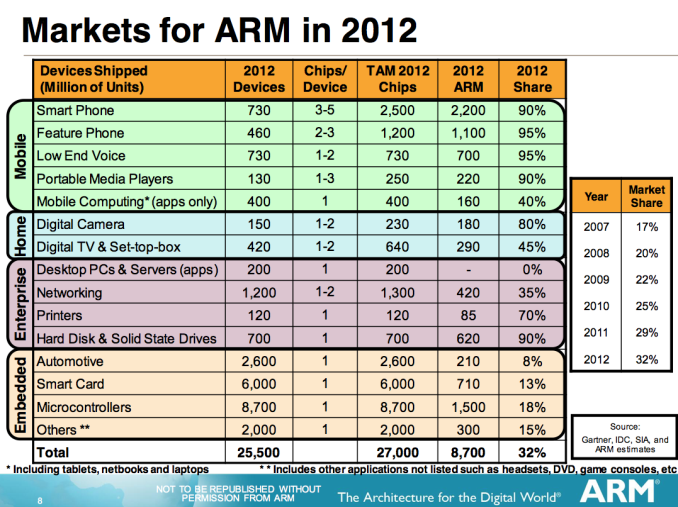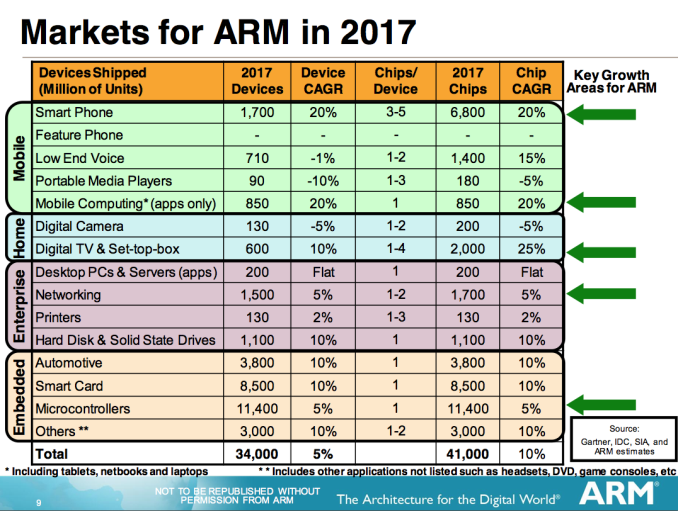The ARM Diaries, Part 1: How ARM’s Business Model Works
by Anand Lal Shimpi on June 28, 2013 12:06 AM ESTMarket Share
In 2012, ARM licensees shipped around 8.7 billion chips. Depending on the market segment, a single device can have anywhere from one to many ARM cores in it. Even looking within a smartphone you have multiple ARM cores not only within the apps processor but also inside the modem.
Although ARM has tremendous market share within the ultra mobile space (90%+), more than half of its shipments come from other segments. Enterprise, digital home, TVs, etc... are all expected to be drivers of growth for ARM in the coming years. By 2017 ARM expects its customers to be shipping roughly 41 billion chips that use ARM IP every year.
Final Words
Business models that leverage the scale and strength of a distributed production model are often very disruptive. ARM designs IP that can be implemented by fabless and fully integrated semiconductor companies very quickly, and at relatively low cost. No one member of the supply chain has to assume a significant amount of risk relative to others in the chain. It’s a far more democratic and partner centric approach to chip supply, which is one reason that it’s done so well.
ARM’s business allows for the creation and sustainability of several chip companies, which in turn keeps prices very low and prevents consolidation of power in any one firm. Although other factors (e.g. modem business, patent licensing) have lead to dominance in specific markets, ARM’s overall impact on the industry is one of promoting competition and keeping (silicon) prices low. ARM quite obviously enables what Qualcomm calls the Internet of things, where nearly everything is connected and computes.
It’s important to note that although our focus on ARM tends to be in the smartphone and tablet space, the majority of its licensed shipments come from other areas. It’s quite likely that ARM’s chances for future growth in terms of margin are in higher-end mobile SoCs, but competition from Intel in one segment surely won’t be the end of the world for ARM.
In the coming parts I’ll be taking a look at some of ARM’s newly announced microprocessor architectures such as the Cortex A12, A53 and A57. I’ll also be looking a little deeper into big.LITTLE and Mali graphics.












64 Comments
View All Comments
Arbee - Friday, June 28, 2013 - link
AMD's clones up through the 486 were true clones of the relevant Intel parts. For the Pentium Intel stopped allowing that and AMD started making their own designs, which at first weren't all that good.ShieTar - Friday, June 28, 2013 - link
Even these days, AMD is somewhat forced to at least copy the INTEL instruction set. At this point, Intel definitly profits from the situation, whatever they decide to include for their CPU, AMD needs to support soon enough in order not to fall back.fluxtatic - Monday, July 1, 2013 - link
The new arch Intel made was Itanium, as they were hoping to get away from x86. We all know how well that worked out.What put AMD behind was Intel's incredibly dirty tricks around the days the Athlon64 was stomping all over Intel - all the backroom deals with Dell and HP, among others, to keep AMD parts out of PCs. Intel would kick in significant amounts of money in both marketing dollars and straight (very illegal) kickbacks to companies that were willing to play ball.
It ended up settling a couple years ago, with Intel paying around $2 billion, as I recall, but that was far too late for the damage done to AMD.
And to Wolfpup's point - there's likely not even money changing hands between Intel and AMD these days - they've both got significant contributions to the x86 architecture that are covered by the cross-licensing agreement. However, likely a lot of the newer features Intel has developed aren't covered, and AMD has to clean-room reverse engineer them if they want to include them in their own designs.
Scannall - Friday, June 28, 2013 - link
There were many reasons for them licensing x86 at the time. And there used to be a whole lot of licensees. AMD is just the last one standing. Other manufacturers were coming up with very good and compelling CPU architectures, and there was really no standard per se. Between contract requirements, and many companies using licensed x86 IP it became the 'standard'.So it looks to me like it was far from a mistake. Use all the licensees to get your architecture king of the hill, then grind them into the grave. Big win for Intel.
rabidpeach - Saturday, June 29, 2013 - link
so arm could be early intel.1. build up cash pile thru licensing
2. buy a fab
3. make it make your exclusive next gen processor that isnt licensed
4. sell it and destroy all the commodity producers
this strategy would need intel to stay on the sidelines.
TheinsanegamerN - Sunday, June 30, 2013 - link
except amd went and sold its fab.slatanek - Friday, June 28, 2013 - link
Great article Anand! It's actually something I have been thinking for a while too (ARM). But I have to admit I miss PODCASTS too! (I'm not the only one as it seems)Callitrax - Friday, June 28, 2013 - link
I'm not so sure the statement "In the PC world, Intel ... ends up being the biggest part of the BoM (Bill of Materials)" is all that accurate. I know it hasn't been for me for 10+ years, the largest part of my BoM is I think the same as a mobile device - the display. Anybody running multiple displays or 1200+ vertical lines (which probably constitutes a large fraction of the readers here) spent spent somewhere between $300 and $800+ dollars which means that they would need an i7 at the low end or i7 extreme at the high end (+PCH) to for Intel's cut to exceed the display cost. And for that matter Samsung just topped the processor in my computer (SSD).* okay technically you could break the monitor BoM into payments to a few companies, but my panel I would guess still exceeds my cpu since the display was $600 on sale.
** and the economics get fuzzed up a little since desktop displays can last through several cpus (mine is on its 3rd cpu and 4 graphics card) whereas mobile device displays are glued to the cpu.
mitcoes - Friday, June 28, 2013 - link
it is possible we will see future ARM64 models where the SoC is plugged in, even a standard connector / format, and be able to upgrade the SoC 2 or 3 times as we do actually with desktop computers. I suggested it to several brands, and I suposse they read the suggestions, and perhaps one will do itname99 - Friday, June 28, 2013 - link
It makes zero sense to optimize for something that is cheap (and part of a cheap system). The days of replaceable cores are gone, just like the days of replaceable batteries. Complaining about them just reveals you as out of touch.There is good physics behind this, not just bitchiness. Mounting which allows devices to be plugged in and out is physically larger, uses more power, and limits frequencies and so performance. There's no point in providing it in most circumstances.
Next to go (for this sort of reason) will be replaceable RAM. It's already not part of the phone/tablet/ultrabook experience, and at some point the performance limitations (as opposed to the size and power issues) will probably mean it's also removed from mainstream desktops.
Complain all you like, but physics is physics. The impedance mismatch from these sorts of connectors is a real problem.